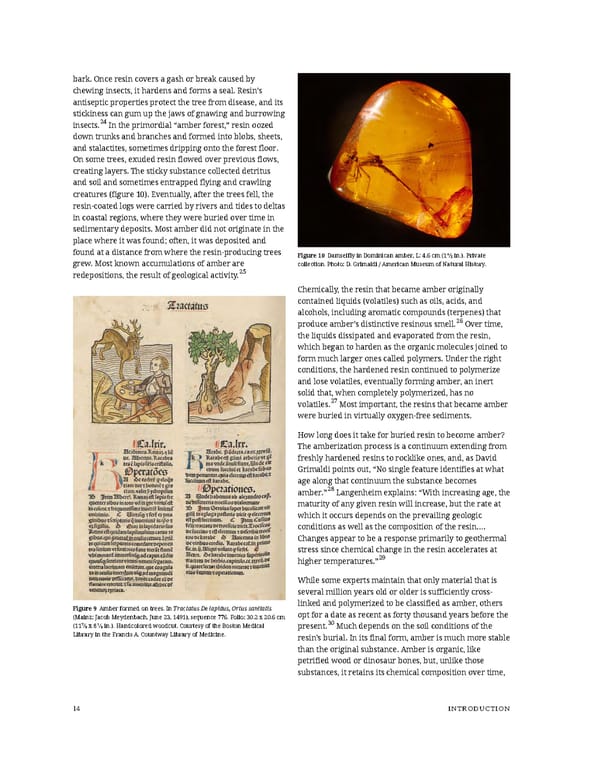bark. Once resin covers a gash or break caused by chewing insects, it hardens and forms a seal. Resin’s antiseptic properties protect the tree from disease, and its stickiness can gum up the jaws of gnawing and burrowing insects.24 In the primordial “amber forest,” resin oozed down trunks and branches and formed into blobs, sheets, and stalactites, sometimes dripping onto the forest floor. On some trees, exuded resin flowed over previous flows, creating layers. The sticky substance collected detritus and soil and sometimes entrapped flying and crawling creatures (figure 10). Eventually, after the trees fell, the resin-coated logs were carried by rivers and tides to deltas in coastal regions, where they were buried over time in sedimentary deposits. Most amber did not originate in the place where it was found; often, it was deposited and found at a distance from where the resin-producing trees Figure 10 Damselfly in Dominican amber, L: 4.6 cm (14⁄ in.). Private 5 grew. Most known accumulations of amber are collection. Photo: D. Grimaldi / American Museum of Natural History. redepositions, the result of geological activity.25 Chemically, the resin that became amber originally contained liquids (volatiles) such as oils, acids, and alcohols, including aromatic compounds (terpenes) that produce amber’s distinctive resinous smell.26 Over time, the liquids dissipated and evaporated from the resin, which began to harden as the organic molecules joined to form much larger ones called polymers. Under the right conditions, the hardened resin continued to polymerize and lose volatiles, eventually forming amber, an inert solid that, when completely polymerized, has no volatiles.27 Most important, the resins that became amber were buried in virtually oxygen-free sediments. How long does it take for buried resin to become amber? The amberization process is a continuum extending from freshly hardened resins to rocklike ones, and, as David Grimaldi points out, “No single feature identifies at what age along that continuum the substance becomes amber.”28Langenheim explains: “With increasing age, the maturity of any given resin will increase, but the rate at which it occurs depends on the prevailing geologic conditions as well as the composition of the resin.… Changes appear to be a response primarily to geothermal stress since chemical change in the resin accelerates at higher temperatures.”29 While some experts maintain that only material that is several million years old or older is sufficiently cross- Figure 9 Amber formed on trees. In Tractatus De lapidus, Ortus sanitatis linked and polymerized to be classified as amber, others (Mainz: Jacob Meydenbach, June 23, 1491), sequence 776. Folio: 30.2 x 20.6 cm opt for a date as recent as forty thousand years before the (117⁄ x 81⁄ in.). Handcolored woodcut. Courtesy of the Boston Medical 30 8 8 present. Much depends on the soil conditions of the Library in the Francis A. Countway Library of Medicine. resin’s burial. In its final form, amber is much more stable than the original substance. Amber is organic, like petrified wood or dinosaur bones, but, unlike those substances, it retains its chemical composition over time, 14 INTRODUCTION
 Ancient Carved Ambers in the J. Paul Getty Museum Page 23 Page 25
Ancient Carved Ambers in the J. Paul Getty Museum Page 23 Page 25